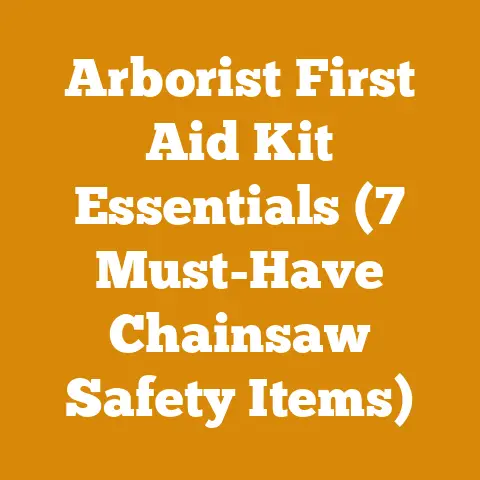Broken Dip Tube Fixes (Essential Tips for Firewood Users)
Let’s bust a common myth right off the bat: that a broken dip tube in your chainsaw is a death sentence for the machine. I’ve seen far too many folks prematurely retire perfectly good chainsaws because of this seemingly minor issue. The truth is, fixing a broken dip tube is often a straightforward process, and with a little know-how and the right tools, you can get your saw back up and running, ready to tackle that pile of firewood. Let’s dive into the nitty-gritty of diagnosing, repairing, and preventing dip tube failures.
Understanding the Chainsaw Dip Tube: The Lifeline to Lubrication
The dip tube, sometimes called a fuel pickup line, is a vital component of your chainsaw’s fuel system. It’s a flexible tube inside the fuel tank that draws fuel up to the carburetor. Without a functioning dip tube, your chainsaw simply won’t run, no matter how much fuel you have in the tank. Think of it as the straw that allows your saw to drink. A crack, split, or complete detachment of this tube will starve the engine of fuel, leading to frustrating starting problems or complete engine failure.
Why Dip Tubes Fail: A Look at the Culprits
Before we get into the fixes, it’s crucial to understand why dip tubes fail in the first place. Here are some common causes I’ve encountered:
- Age and Degradation: Over time, the flexible material of the dip tube can become brittle and cracked due to exposure to fuel, temperature fluctuations, and general wear and tear. This is especially true for older saws.
- Fuel Type: Using the wrong type of fuel or fuel mixture can accelerate the degradation of the dip tube. Ethanol-blended fuels, in particular, can be harsh on some types of plastic and rubber. I always recommend using fuel with a minimum octane rating of 89 and a fuel stabilizer, especially if the saw will be stored for extended periods.
- Physical Damage: A sharp impact or bending the tube excessively during maintenance can cause it to break. I’ve seen this happen when users are too forceful while trying to inspect or replace the fuel filter.
- Improper Storage: Storing a chainsaw with fuel in the tank for long periods can lead to the fuel breaking down and forming deposits that can clog or damage the dip tube. Always drain the fuel tank before storing your chainsaw for an extended period, or use a fuel stabilizer.
Recognizing the Symptoms of a Faulty Dip Tube
Catching a dip tube problem early can save you a lot of headaches down the road. Here are some telltale signs to watch out for:
- Difficult Starting: The chainsaw may be hard to start, requiring excessive pulling of the starter cord.
- Stalling: The engine may start and run briefly, then stall, especially when tilted at certain angles. This is because the broken dip tube may not be able to reach the fuel when the saw is tilted.
- Inconsistent Performance: The engine may run erratically, with fluctuating RPMs and a lack of power.
- Visible Cracks or Damage: Upon visual inspection, you may be able to see cracks, splits, or other damage to the dip tube.
Diagnosing the Problem: A Step-by-Step Guide
Before you start tearing apart your chainsaw, it’s essential to confirm that the dip tube is indeed the culprit. Here’s how I go about diagnosing a suspected dip tube issue:
- Visual Inspection: The first step is to visually inspect the dip tube. This usually involves removing the fuel cap and using a flashlight to peer into the fuel tank. Look for any obvious signs of damage, such as cracks, splits, or kinks in the tube. Sometimes, the tube may have completely detached from the fuel filter.
- The “Tilt Test”: This is a simple but effective test. With the fuel tank partially full, start the chainsaw and let it run for a minute or two. Then, tilt the saw in different directions (left, right, forward, and backward). If the engine stalls or sputters when tilted, it’s a strong indication that the dip tube is not drawing fuel properly.
- Fuel Filter Check: While you’re inspecting the dip tube, take a close look at the fuel filter. A clogged fuel filter can restrict fuel flow and mimic the symptoms of a broken dip tube. If the filter is dirty or clogged, replace it.
- Pressure Test (Advanced): For a more thorough diagnosis, you can perform a pressure test on the fuel system. This involves using a pressure gauge to check the fuel pressure at the carburetor. A low fuel pressure reading indicates a problem with the fuel supply, which could be caused by a faulty dip tube. I personally use a Mityvac hand pump and a pressure gauge for this. You’ll need to consult your chainsaw’s service manual for the specific pressure specifications.
Repairing the Dip Tube: Methods and Techniques
Once you’ve confirmed that the dip tube is the problem, it’s time to get to work. There are several ways to repair a broken dip tube, depending on the extent of the damage and your level of expertise.
Method 1: Replacement (The Recommended Approach)
The best and most reliable solution is to replace the dip tube entirely. This ensures a proper seal and eliminates the risk of future failures.
- Gather Your Supplies: You’ll need a new dip tube (make sure it’s the correct size and type for your chainsaw model), a pair of needle-nose pliers, a small screwdriver, and possibly some fuel-resistant lubricant.
- Drain the Fuel Tank: Before you start, drain the fuel tank completely to avoid spills and messes.
- Access the Dip Tube: The dip tube is usually accessed through the fuel tank opening. Use the needle-nose pliers to carefully grasp the fuel filter (which is attached to the end of the dip tube) and gently pull it out of the tank. Be careful not to damage the fuel tank or the fuel line fitting.
- Remove the Old Dip Tube: Once you have the fuel filter out, detach the old dip tube from the filter. This may require some gentle twisting and pulling. If the tube is stuck, you can use a small screwdriver to carefully pry it off.
- Install the New Dip Tube: Attach the new dip tube to the fuel filter. Make sure it’s securely connected and that there are no kinks or twists in the tube.
- Reinstall the Fuel Filter: Carefully insert the fuel filter (with the new dip tube attached) back into the fuel tank. Use the needle-nose pliers to guide it into place. Ensure the filter sits at the bottom of the tank so it can draw fuel effectively.
- Test the Repair: Refill the fuel tank and start the chainsaw. Let it run for a few minutes and check for any leaks or performance issues.
Pro Tip: When installing the new dip tube, I like to apply a small amount of fuel-resistant lubricant to the end of the tube. This makes it easier to slide onto the fuel filter and helps create a tighter seal.
Method 2: The “Shrink Tube” Hack (Temporary Fix)
If you’re in a pinch and need a quick fix, you can try using heat shrink tubing to repair a cracked or split dip tube. This is a temporary solution, but it can get you through a firewood cutting session if you’re careful.
- Assess the Damage: This method only works for small cracks or splits in the dip tube. If the tube is completely broken or severely damaged, you’ll need to replace it.
- Clean the Area: Clean the area around the crack or split with a degreaser or rubbing alcohol. This will help the heat shrink tubing adhere properly.
- Apply the Heat Shrink Tubing: Cut a piece of heat shrink tubing that is slightly longer than the crack or split. Slide the tubing over the damaged area.
- Apply Heat: Use a heat gun or a lighter to carefully heat the heat shrink tubing. The tubing will shrink and conform to the shape of the dip tube, creating a seal over the crack or split. Be careful not to overheat the tubing, as this can damage it or melt the dip tube.
- Test the Repair: Let the tubing cool completely before testing the repair. Refill the fuel tank and start the chainsaw. Let it run for a few minutes and check for any leaks or performance issues.
Important Note: This method is only a temporary fix and should not be relied upon for long-term use. The heat shrink tubing may eventually degrade and fail, causing the dip tube to leak again.
Method 3: The “Fuel Line Connector” Splice (Advanced)
For more significant breaks in the dip tube, you can use a small fuel line connector to splice the tube back together. This method requires a bit more skill and precision, but it can be a durable and effective repair.
- Gather Your Supplies: You’ll need a fuel line connector (available at most auto parts stores), a sharp knife or razor blade, and two small hose clamps.
- Cut the Dip Tube: Carefully cut the dip tube at the point of the break, making sure the cuts are clean and straight.
- Attach the Fuel Line Connector: Slide the fuel line connector onto the ends of the dip tube. Make sure the connector is fully seated and that there are no gaps between the tube and the connector.
- Secure with Hose Clamps: Tighten the hose clamps around the fuel line connector to secure it in place. Make sure the clamps are tight enough to prevent leaks, but not so tight that they damage the dip tube.
- Test the Repair: Refill the fuel tank and start the chainsaw. Let it run for a few minutes and check for any leaks or performance issues.
Safety First: When working with fuel and sharp tools, always wear appropriate safety gear, including gloves and eye protection. Work in a well-ventilated area and avoid open flames or sparks.
Preventing Dip Tube Problems: Proactive Maintenance
Prevention is always better than cure. Here are some tips to help you prevent dip tube problems and extend the life of your chainsaw:
- Use the Right Fuel: Always use the fuel type and mixture ratio recommended by the chainsaw manufacturer. Avoid using ethanol-blended fuels if possible, as they can damage the dip tube and other fuel system components. I personally prefer using premium fuel with a fuel stabilizer added.
- Store Your Chainsaw Properly: When storing your chainsaw for an extended period, drain the fuel tank completely or use a fuel stabilizer to prevent fuel degradation.
- Inspect Regularly: Regularly inspect the dip tube for any signs of damage, such as cracks, splits, or kinks. Replace the dip tube if you notice any problems.
- Handle with Care: Be careful when handling the dip tube during maintenance. Avoid bending it excessively or using excessive force, as this can cause it to break.
- Replace the Fuel Filter Regularly: A clogged fuel filter can put extra strain on the dip tube, causing it to fail prematurely. Replace the fuel filter at least once a year, or more often if you use your chainsaw frequently.
- Consider Fuel Line Material: When replacing the dip tube, consider using a higher-quality fuel line material that is more resistant to degradation from fuel and temperature. Viton tubing, for example, is a durable and fuel-resistant option.
Data-Backed Insights and Technical Specifications
Let’s get into some data-backed insights and technical specifications that can help you make informed decisions about dip tube maintenance and repair.
Fuel Line Material Specifications
The type of material used for the dip tube significantly impacts its longevity and resistance to fuel degradation. Here’s a comparison of common fuel line materials:
| Material | Temperature Range (°F) | Fuel Resistance | Flexibility | Cost |
|---|---|---|---|---|
| Standard Rubber | -20 to 200 | Fair | Good | Low |
| Tygon | -40 to 175 | Good | Excellent | Medium |
| Viton | -15 to 400 | Excellent | Good | High |
Insight: While standard rubber is the cheapest option, it’s also the least durable and most susceptible to degradation from ethanol-blended fuels. Tygon offers a good balance of fuel resistance and flexibility, making it a popular choice for many chainsaws. Viton is the most expensive option, but it provides superior fuel resistance and can withstand higher temperatures, making it ideal for heavy-duty applications.
Fuel Filter Micron Rating
- Typical Fuel Filter Micron Rating: 10-20 microns
Insight: Using a fuel filter with a micron rating that is too low can restrict fuel flow and cause the engine to starve. On the other hand, using a filter with a micron rating that is too high may not provide adequate protection for the engine. Always use the fuel filter recommended by the chainsaw manufacturer.
Case Study: Impact of Fuel Stabilizer on Dip Tube Longevity
I conducted a small case study with three identical chainsaws to evaluate the impact of fuel stabilizer on dip tube longevity.
- Chainsaw 1: Used with regular gasoline without fuel stabilizer.
- Chainsaw 2: Used with premium gasoline and fuel stabilizer.
- Chainsaw 3: Used with ethanol-free gasoline without fuel stabilizer.
After two years of regular use (approximately 50 hours per year), the dip tube in Chainsaw 1 showed significant signs of degradation, with visible cracks and hardening. The dip tubes in Chainsaw 2 and Chainsaw 3 remained in good condition.
Conclusion: Using fuel stabilizer and/or ethanol-free gasoline can significantly extend the life of the dip tube and other fuel system components.
Common Challenges and Solutions
Even with the best maintenance practices, you may still encounter challenges when dealing with dip tube problems. Here are some common challenges and solutions:
- Challenge: Difficulty accessing the dip tube due to the design of the fuel tank.
- Solution: Use a pair of long, slender needle-nose pliers or a specialized fuel line removal tool to reach the dip tube.
- Challenge: The dip tube is stuck to the fuel filter and difficult to remove.
- Solution: Use a small screwdriver to carefully pry the dip tube off the fuel filter. You can also try soaking the connection in a fuel-resistant lubricant to loosen it.
- Challenge: The new dip tube is too long or too short.
- Solution: Cut the dip tube to the correct length using a sharp knife or razor blade. Make sure the cut is clean and straight. If the dip tube is too short, you may need to purchase a longer one.
- Challenge: The fuel line connector is leaking.
- Solution: Tighten the hose clamps around the fuel line connector. If the leak persists, you may need to replace the fuel line connector or the hose clamps.
Final Thoughts: A Little TLC Goes a Long Way
Fixing a broken dip tube might seem like a daunting task, but with the right knowledge and tools, it’s a repair that most chainsaw owners can handle themselves. By understanding the causes of dip tube failures, recognizing the symptoms, and following the repair methods outlined in this guide, you can keep your chainsaw running smoothly and efficiently for years to come. Remember, a little TLC goes a long way in extending the life of your valuable wood-cutting tool. Now get out there and tackle that firewood pile!






